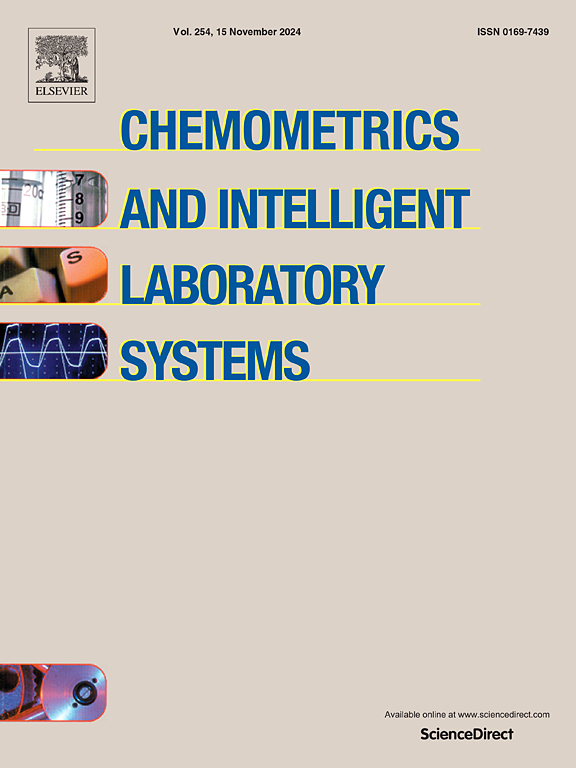GAN-ML:通过创新的深度卷积生成对抗网络数据增强技术推进抗癌肽预测
IF 3.8
2区 化学
Q2 AUTOMATION & CONTROL SYSTEMS
Chemometrics and Intelligent Laboratory Systems
Pub Date : 2025-04-10
DOI:10.1016/j.chemolab.2025.105390
引用次数: 0
摘要
有限和不平衡的数据阻碍了抗癌肽(ACP)的预测,经常导致对未知肽的过度拟合和性能差。为了解决这些挑战,我们提出了一种基于深度卷积生成对抗网络(DC-GAN)的数据增强方法。该方法通过生成具有抗癌特性的肽,有效地扩展了训练数据集,特别是代表性不足的类,如N+型acp,其特征是在N端具有丰富的正残基,这在抗癌肽预测中仍然是一个遗忘问题。与合成少数过采样技术(SMOTE)和编辑近邻SMOTE (SMOTEENN)等传统方法相比,DC-GAN通过解决有限的训练样本和类内不平衡(如C+和N+型肽之间的不平衡)显示出优越的性能。所提出的框架,GAN-ML级联线性模型和集成模型,实现准确率为82.96%(独立测试),96.06%(独立测试)和94.06%(5倍交叉验证),用于在不同数据集上将肽分类为抗癌,抗菌或非抗癌,整合基于ACPs基序的认证和基于物理化学性质的验证。这些结果突出了基于dc - gan的数据增强在增强模型泛化,通过生成具有少数代表性的样本来提高性能以及作为生成抗癌药物发现的强大工具方面的有效性。本文章由计算机程序翻译,如有差异,请以英文原文为准。
GAN-ML: Advancing anticancer peptide prediction through innovative Deep Convolution Generative Adversarial Network data augmentation technique
Limited and imbalanced data hinder anticancer peptide (ACP) prediction, often resulting in over-fitting and poor performance on unseen peptides. To address these challenges, we propose a Deep Convolution Generative Adversarial Network (DC-GAN) based data augmentation method. This approach effectively expands the training dataset by generating peptides with anticancer properties, particularly underrepresented class such as N+ type ACPs, characterized by abundant positive residues in the N-terminus, which remain amnesic problem in anticancer peptide prediction. Compared to traditional methods like Synthetic Minority Over-sampling Technique (SMOTE) and SMOTE with Edited Nearest Neighbors (SMOTEENN), DC-GAN demonstrates superior performance by addressing both limited training samples and within-class imbalances, such as those between C+ and N+ type peptides. The proposed framework, GAN-ML cascade a linear model and an ensemble model, achieving accuracy rates of 82.96% (independent test), 96.06% (independent test), and 94.06% (5-fold cross-validation) for classifying peptides as anticancer, antimicrobial, or non-anticancer across various datasets integrating ACPs motif based authentication and physio-chemical properties based validation. These results highlight the efficacy of DC-GAN-based data augmentation in enhancing model generalization, improving performance by generating a samples with minority representation, and serving as a powerful tool for generative anticancer drug discovery.
求助全文
通过发布文献求助,成功后即可免费获取论文全文。
去求助
来源期刊
CiteScore
7.50
自引率
7.70%
发文量
169
审稿时长
3.4 months
期刊介绍:
Chemometrics and Intelligent Laboratory Systems publishes original research papers, short communications, reviews, tutorials and Original Software Publications reporting on development of novel statistical, mathematical, or computer techniques in Chemistry and related disciplines.
Chemometrics is the chemical discipline that uses mathematical and statistical methods to design or select optimal procedures and experiments, and to provide maximum chemical information by analysing chemical data.
The journal deals with the following topics:
1) Development of new statistical, mathematical and chemometrical methods for Chemistry and related fields (Environmental Chemistry, Biochemistry, Toxicology, System Biology, -Omics, etc.)
2) Novel applications of chemometrics to all branches of Chemistry and related fields (typical domains of interest are: process data analysis, experimental design, data mining, signal processing, supervised modelling, decision making, robust statistics, mixture analysis, multivariate calibration etc.) Routine applications of established chemometrical techniques will not be considered.
3) Development of new software that provides novel tools or truly advances the use of chemometrical methods.
4) Well characterized data sets to test performance for the new methods and software.
The journal complies with International Committee of Medical Journal Editors'' Uniform requirements for manuscripts.

 求助内容:
求助内容: 应助结果提醒方式:
应助结果提醒方式:


